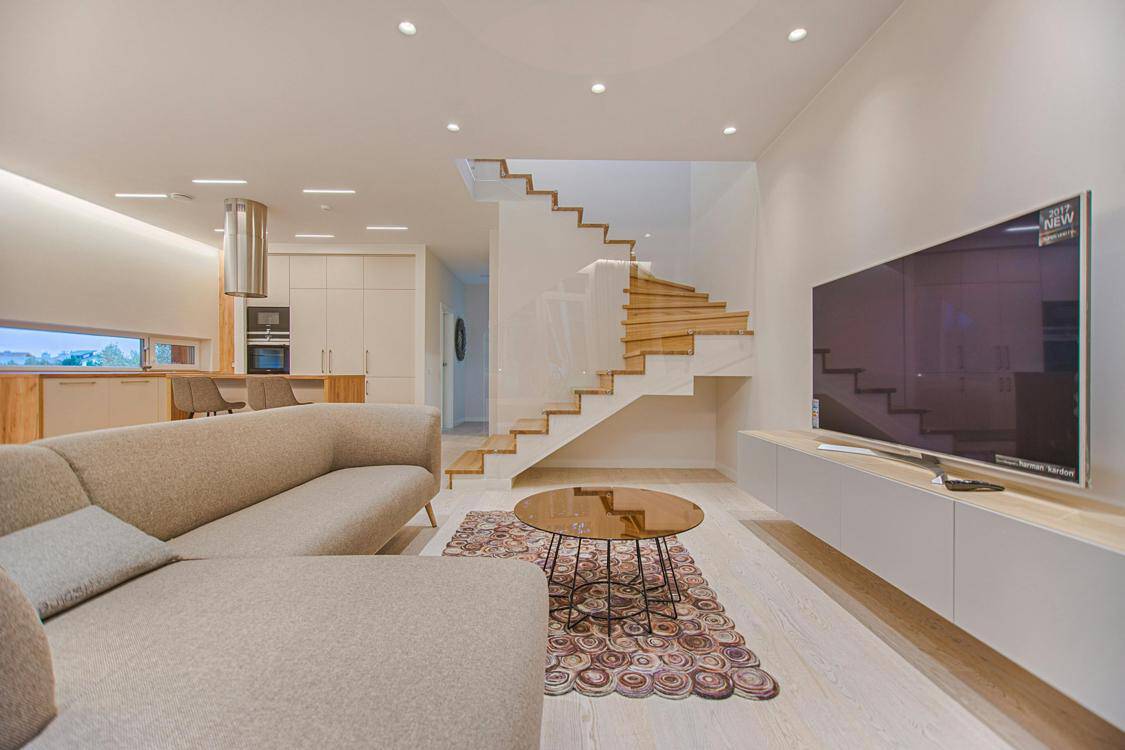Minimalism may seem bare and boring at first glance, but it can also add interest to spaces by highlighting quality over quantity. Using pure planes and neutral colors to emphasize space, form, and function is a powerful strategy.
Considered minimalism can include smart home integration, streamlined furniture, and multi-functional pieces. Ultimately, minimalism is about “form follows function,” creating connected open spaces where every piece has a purpose.
1. Less is More
Minimalism is an all-encompassing design philosophy that seeks to eliminate the clutter from homes to make them more functional and inviting. By emphasizing quality over quantity, minimalist design allows homeowners to create spaces that speak deeply to their personal values and lifestyles.
This approach to interior design also helps promote a healthy, organized home environment, as it reduces allergens and stress and fosters a sense of calm. The benefits of minimalism also extend to cost savings, as streamlined designs require less cleaning and maintenance.
While minimalism focuses on the importance of clean, empty spaces, it does not exclude decorative elements. In fact, the key to implementing minimalist design is selecting decorative pieces that are of high-quality and simple in form. For example, using an elegant marble tabletop can add visual interest to a room without overwhelming the space.
Another way to achieve a minimalist aesthetic is by introducing textured surfaces into your home. This can add visual appeal and provide a contrast to the sleek surfaces of minimalism. The varying textures of natural materials such as wood, stone, and even concrete can complement the smooth planes and pure colors of minimalist design.
Minimalist architects often use a method known as “subtractive design,” which is when they remove as much of the excess material as possible from their original blueprint. The result is a clean, modern home that is easy to maintain. This design technique is also a great way to create a timeless look that will stand the test of time, and can help minimize the need for costly renovations in the future.
2. Clean Lines
It’s easy to confuse minimalism with bare spaces, but clean lines are crucial for this style. This means keeping surfaces free of clutter, introducing furniture pieces with smooth and straight shapes, and using neutral colors that create a sense of openness. These simple design tricks help to visually expand rooms, making them feel larger and more spacious.
Minimalist interiors also prioritize function, ensuring that every piece of furniture and decor serves a purpose. This approach reduces visual distractions and promotes a more organized, stress-free living environment. Neutral tones are preferred, as they create a feeling of tranquility and promote natural light flow throughout the space.
The purity and clean planes of minimalist designs also highlight any small imperfections or details that may be present in the home. This is why it’s so important to regularly declutter and maintain a well-organized home. It’s also why it’s a good idea to shop intentionally and choose quality pieces that will last for years to come.
When it comes to lighting, a minimal design can benefit from clever fixtures that illuminate the space without overpowering it. Excellent minimal designs can be taken from Blokk Studio. Large windows also allow sunlight to circulate throughout the space, creating a feeling of openness and connectedness between rooms.
When it comes to patterns, minimalist designs typically feature geometric elements and muted colors. These patterned accents provide visual interest without being too overpowering.
3. Intentional Storage
A minimalist interior is all about clean lines and a neat appearance. This is why storage solutions are essential for a minimal space. When a room is filled with clutter, it is difficult to see the clean lines and beautiful colors that are so important in minimalism. It’s also easy for the slightest details to get smudged by the dust and dirt that accumulates quickly in an untidy home. To combat this, it’s crucial to keep surfaces clean and organized by regularly decluttering and investing in smart storage options that will allow you to conceal away items when they’re not in use.
Fortunately, there are plenty of creative and efficient ways to create smart storage solutions that will fit the needs of your minimalist design. For example, incorporating multifunctional furniture pieces like a versatile ottoman that doubles as additional seating can help to maximize storage while maintaining a sleek, modern aesthetic. This allows you to keep your paths clear while keeping your most important belongings easily accessible.
Another way to keep your minimalist design clean is by utilizing negative space. Negative space is the empty space that is left behind furniture or decorations. This is a key element in minimalism and can be achieved by limiting the amount of art or wall decor you have hanging on your walls, or by creating open shelving. Using negative space in your minimalist design can make the room feel bigger and more spacious and will draw attention to the areas that are most important in your design.
Finally, maximizing natural light is vital to minimalism. This allows the sun to shine in and brighten the space, which can boost the feeling of airiness and visual clarity that is so characteristic of a minimalist design. Leaving windows uncovered and integrating light-colored furnishings will further enhance the effects of natural light, allowing it to penetrate more fully into your minimalist space.
4. Natural Light
Minimalists embrace natural light because it creates a sense of airiness and breeziness in a room. It also improves visual comfort and helps avoid eye strain. Using large windows and glazed doors is the best way to incorporate natural light in a minimalist design, but even smaller windows can have a huge impact on the overall look of a room.
When it comes to lighting, minimalism favors neutral hues such as whites and greys for the primary background and accent colors. However, a minimal color palette can still be very vibrant if you introduce variations in texture throughout the space. Minimalist furniture is often crafted from sleek wood, smooth lines and minimal detailing that allows for natural light to flow freely through the furniture and into the room.
A varied combination of strategically selected and positioned light fixtures can elevate the minimalist aesthetic. Soft lighting, such as backlighting behind mirrors or artworks, creates a cozier feel and enhances the visual interest of these elements. Minimalists also tend to use recessed lights, LED strip lights and floor lamps in place of table lamps to avoid overcrowding their spaces with multiple light sources.
If you have a show-stopping piece of furniture, such as an ornate red table in your living room, consider framing the piece with minimal artwork to draw attention away from the furniture and toward the art. This is one of the only ways to incorporate a pop of color into a minimalist design without violating the rule of less is more.
Minimalists prioritize multi-functionality in their furnishings, so it’s important to look for integrated pieces that serve more than one purpose. For example, this minimalist loft’s angular oak platform bed and floating nightstands merge seamlessly into a headboard that doubles as the mount for a pair of sconces. The same concept can be applied to other room elements, such as built-in shelving and bookcases that meld into their storage compartments.
5. Statement Pieces

Using minimalist colors like whites, greys and earthy tones can make your home feel clean and open. But minimalism is more than just a palette, it’s also about how you use furniture, accessories and other design elements to create a unified and balanced space.
Minimalists are always experimenting with their personal lives, trying new things and pushing the boundaries of what they think is possible. This philosophy extends to their homes, where they want to live in a way that is streamlined and efficient.
One of the best ways to achieve a clean and minimalist aesthetic is by choosing center pieces that are both functional and eye-catching. This could be a piece of art that stands out in an otherwise neutral room, or a unique light fixture that draws attention. Using a single standout element as a focal point allows the rest of the room to complement and accentuate it.
Another key to creating a minimal space is adding texture through the use of materials and patterns. Using varying textures within a monochromatic color scheme allows you to add “variety within unity” and helps your space look more interesting. Using textured fabrics like rugs, linen wallpaper or even woven baskets can give your home a unique touch and add interest to a simple design.
Minimalists understand that time is precious, and they don’t want to waste it on things that aren’t necessary for their happiness or well-being. This approach applies to their homes as well, where they only keep the items that serve a purpose and are truly meaningful to them. Whether it’s an iconic piece of furniture or a bold piece of art, minimalism is about choosing the things that really matter in life and removing the clutter from your home.





